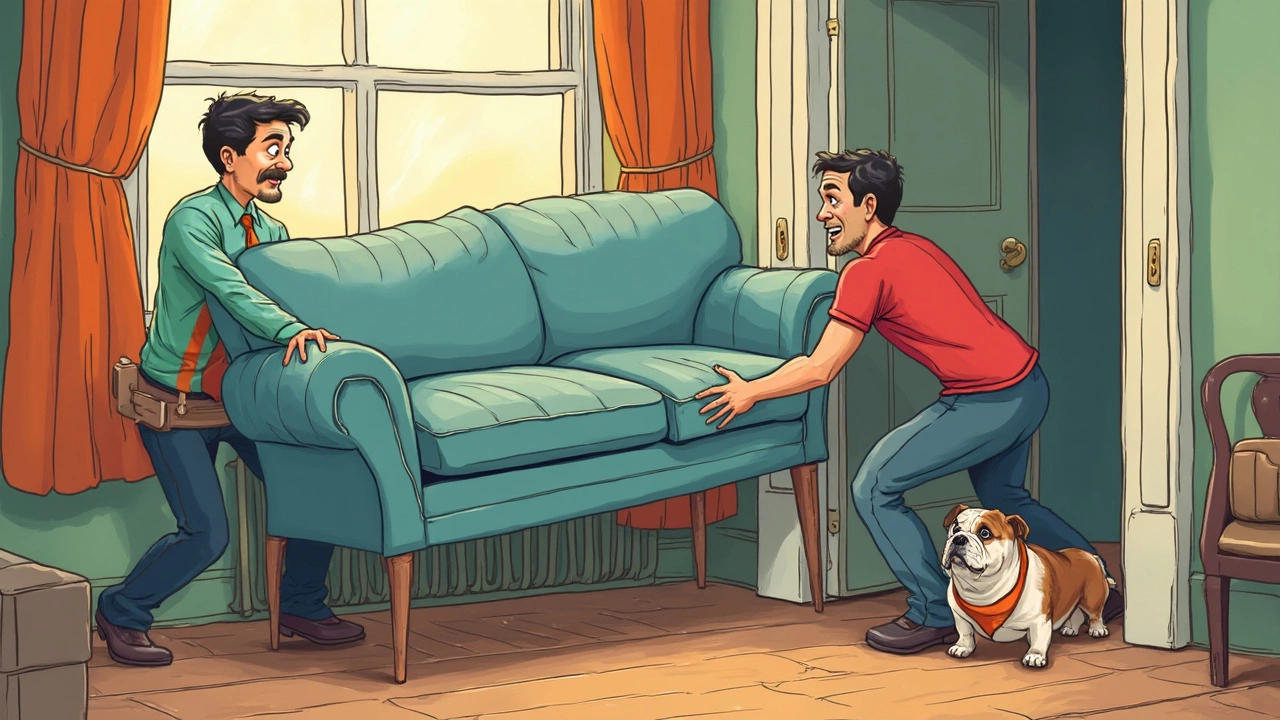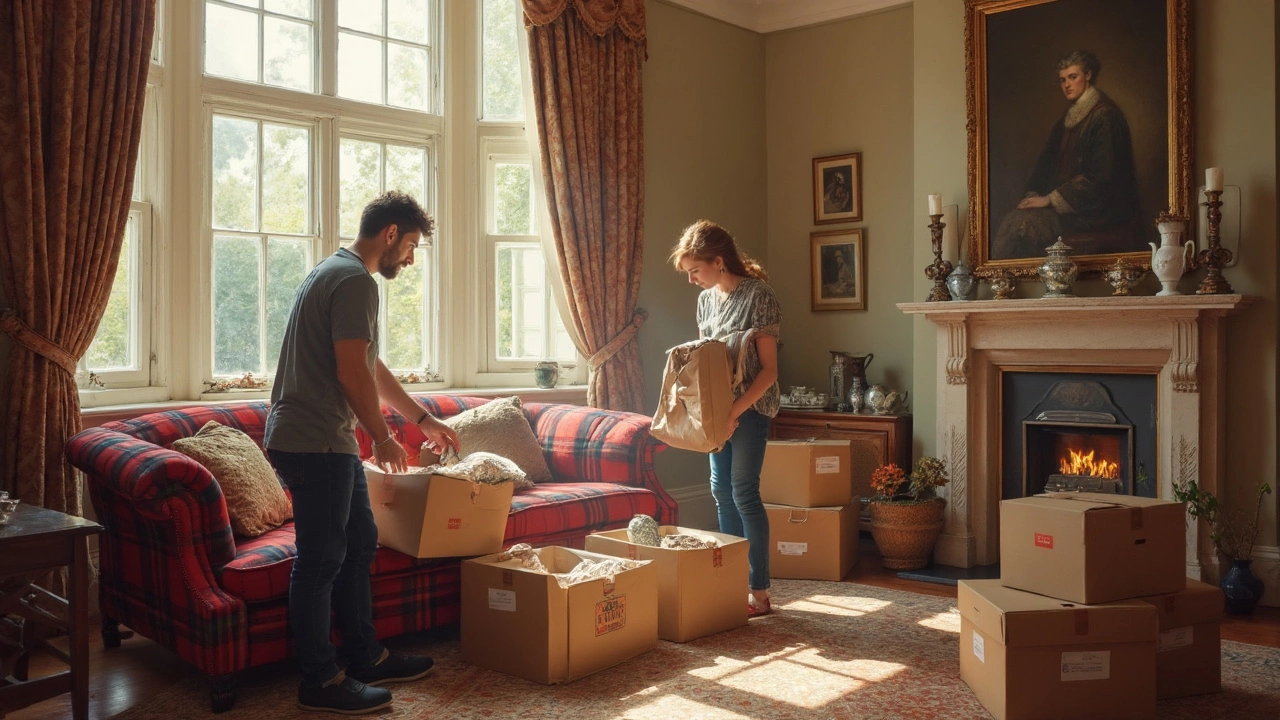Ever tried squeezing a bulky sofa through a narrow doorway? Not fun, right? Here's a cool tip: removing the couch cushions can make your life a whole lot easier! It sounds simple, but it’s a game-changer when you're trying to maneuver that beast out the door.
Taking off the cushions makes the sofa lighter, allowing you to handle it more easily. Plus, with the cushions packed separately, you reduce the risk of damage—not just to the cushions but to the sofa frame too! Unzipping and packing each cushion might seem like an extra chore, but trust me, it’s far better than the headache of wrestling with an unwieldy couch.
- Why Removing Couch Cushions Matters
- Benefits of Taking Cushions Off
- How to Safely Remove and Pack Cushions
- Avoiding Common Cushion Mishaps
- When to Keep Cushions On
- Extra Tips for Moving Sofas
Why Removing Couch Cushions Matters
Picture this: you're halfway through moving your giant sofa, and it won't fit through the doorway. What gives? It turns out, those bulky couch cushions could be the culprits. By taking them off, you're not just trimming the sofa's width; you're making the entire thing more maneuverable.
Imagine how easy it would be to lift a lighter couch. Fewer cushions mean less weight — a simple math that saves your back! With the bulk reduced, you get better control while navigating tight spots, like hallways and elevators.
Preserving Your Furniture
Removing cushions isn't just about squeezing through small spaces. It's about keeping your furniture in top-notch shape. When left in place, cushions are prone to getting snagged on door frames or brushed up against rough walls, which can lead to tears and scratches.
Protecting the Cushions
Let's not forget about the cushions themselves. Were you aware that they tend to collect dirt during moves? Packing them separately protects these fluffy giants from grime and potential damage.
Here’s a fun fact: 60% of movers say removing and packing cushions separately saved them from accidental couch damage! Having those extras safely tucked away makes each stage of moving less stressful.
Benefits of Taking Cushions Off
So, you're packing up for a move and wondering whether to yank those couch cushions off? The short answer: yes, and here's why. First off, removing cushions lightens the sofa, which is a huge plus when you're lugging it through doorways or up those treacherous stairs.
Easier Handling
Without the cushions, your furniture becomes less bulky and more manageable. This reduces the chance of furniture bumping into walls or damaging door frames during the move. It’s not just practical for big sofas—sectionals benefit the most, as they often have numerous cushions adding to their weight and size.
Damage Prevention
By removing and packing sofa cushions separately, you also minimize wear and tear. Cushions can snag and rip when stuck in tight spots, but stored in a box, they’re safe from harm. This is especially key if you've got fancy materials or one of those plush designs that everyone envies.
Better Space Utilization
Putting cushions in boxes or vacuum bags allows more efficient use of moving truck space. Rather than an awkward lumpy couch fit, you’ve got a compact frame and neatly stacked boxes.
Table of Effectiveness
| Method | Weight Reduction | Handling Ease |
|---|---|---|
| With Cushions | Minimal | Moderate |
| Without Cushions | Significant | High |
If you're considering leaving cushions on, remember the moving day struggle is real. A little prep can turn potential chaos into a smooth operation. So go ahead, start unzipping!
How to Safely Remove and Pack Cushions
Before diving into the packing frenzy, think about the condition of your couch cushions. Are they attached or loose? Most are detachable, making it a breeze to remove them. Just unzip the covers and gently slide out the inserts. If you find them stubbornly fixed, check for hidden clips or fastenings.
Step-by-Step Cushion Removal
- Assess Fastenings: Before anything else, check if the cushions are held with zippers or Velcro. Some might even have buttons.
- Detach Gently: Use a steady hand to unzip or unclip, preventing unnecessary damage.
- Handle with Care: Avoid using sharp objects around the fabric. They can easily tear or snag the cushion covers.
Packing Your Cushions
It's not just about stuffing them into a bag. With a little forethought, you can protect their integrity and make unpacking a cinch.
- Use Large Plastic Bags: Seal each cushion in its own bag to protect against dust and moisture. Vacuum-sealable bags are golden for saving space.
- Label Everything: Mark each bag with its cushion's designated spot - think of it as a fast pass for furniture reassembly.
- Stack Smartly: If your moving truck layout allows, lay the cushions flat to prevent warping over time.
Once you have them all packed, make sure to place the packed cushions in an area where they won't get squashed, like on top of other soft furnishings. Bonus tip: This might be the perfect time to give those covers a wash when you arrive at your new place!
For those considering their moving expenses, research shows that just a little effort into efficiently packing can shave hours off your moving day, potentially saving you some serious cash on hourly moving rates.

Avoiding Common Cushion Mishaps
Navigating the world of cushion removal during a move can be a bit tricky, but knowing the pitfalls can save you a ton of trouble.
Protecting Cushions from Dirt and Damage
First up, once you remove those cushy pillows, you’ve got to keep them from getting grimy. Wrap each cushion in a sturdy plastic bag or use a moving blanket. This not only keeps them clean but also guards against any unexpected rips or tears.
Keeping Track of Everything
When you're juggling so many pieces, it's easy to lose track. Make sure you label each cushion and its bag with a quick sticky note so you remember which piece goes where. Trust me, this little step can save you from a post-move puzzle later!
Avoid Overpacking
Shoving too many cushions into one box is a common mishap that folks regret later. Not only can it cause stress on the cushions, but it also makes the box super heavy. Stick to one or two cushions per box.
Handle with Care
Once you’ve wrapped and packed, make sure you don’t stack heavy items on top. As tempting as it might be to use the cushion box to prop up something heavier, resist! Keeping them on top or separately ensures they keep their shape.
| Common Mistake | Consequence | Solution |
|---|---|---|
| Not wrapping cushions | Dirty, damaged cushions | Use plastic bags |
| Overpacking boxes | Heavy boxes, damaged cushions | Limit to 1-2 cushions per box |
| No labels on cushions | Mixed-up pieces | Label each cushion |
By being mindful of these simple yet crucial steps, you can ensure that all your moving endeavors are as smooth as butter, without any cushion calamities.
When to Keep Cushions On
So you might be thinking, why not always take them off? Well, there are actually some situations where it makes more sense to leave those couch cushions where they are.
Short Distances
If you're just moving the sofa a few feet or to another room in the same house, you might not need to remove the cushions. Saves time and effort, especially since there's no need to over-complicate a simple shift.
Fixed Cushion Design
Some sofas have cushions that are sewn into the sofa itself, making them non-removable. In these cases, it's obviously impossible to detach them! Trying to force it could lead to unnecessary tears or damage.
Protect the Frame
Believe it or not, sometimes leaving cushions on can actually protect your sofa's frame. They act as a buffer, preventing scratches or dents that might happen if the bare frame bumps into walls or doorframes during transit.
Special Features
Sofas with built-in storage or recliner mechanisms might actually hold up better with cushions kept in place. This keeps any loose elements from jiggling around too much, which could cause damage inside.
Prevent Loss or Misplacement
Finally, if you're worried about losing or misplacing cushions, especially for intricate multi-part sets, keeping them attached can help ensure that every piece arrives at your destination together.
Overall, while removing cushions often makes life easier during long moves, sometimes it’s best to let them stay put for short moves or with these special cases.
Extra Tips for Moving Sofas
Moving a sofa isn't as straightforward as you might think, especially if you want to keep your furniture and walls scratch-free! Here are some solid tips to make life easier, save time, and protect your space.
Measure Your Pathways
Grab a tape measure and size up doorways, hallways, and stairways. This way, you'll know if the sofa fits before you get to the awkward twisting and turning stage. Trust me, nothing's worse than getting stuck halfway through!
Disassemble When Possible
If your sofa's got removable legs or can be disassembled, do it! This can make the whole thing much lighter and easier to maneuver. Just remember to keep all screws and bits together—nothing worse than searching for that one missing piece after the move.
Protect your Sofa and Property
Before you start moving, wrap the couch in moving blankets or plastic wrap to ward off scratches. It's like giving your sofa armor for the journey!
- Wrap each section separately if possible.
- Use plastic sliders for hardwood floors to prevent scratches.
Use Proper Lifting Techniques
Lift with your legs, not your back. You’ve probably heard it a million times, but it’s crucial. Also, having a friend is great—not just for moral support, but for helping balance those awkward sofa lengths.
Plan Your Route
Plan out the exact path you'll take with the sofa. Consider things like sharp turns or obstacles. It’s kind of like playing a video game where you pre-plan your path to avoid ‘enemy’ furniture!
Lastly, if you’re moving to an apartment, check in with your building management. Some places have rules about moving times or using service elevators—no need for a dramatic last-minute panic!


